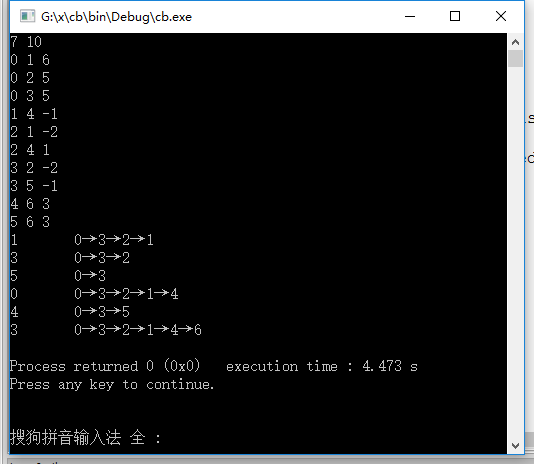——————有向圖——————

①鄰接表(效率較高)
#include <iostream>
#include <cstdio>
#include <cstring>
#include <cmath>
#include <vector>
#include <queue>
#include <map>
#include <algorithm>
using namespace std;
#define INF 0xfffffff
#define MAXN 1010
struct Edge
{
int u,v,w;
};
Edge edge[MAXN];//鄰接表
int n,m;//頂點數和邊數
int dist[MAXN];//頂點s到其他頂點的最短路徑、
int path[MAXN];//path[i]表示v0到vi的最短路徑上vi的前一個頂點的序號
int shortest[MAXN];//輸出最短路徑上的各個頂點時存放的各個頂點的序號
void Bellman(int s)//頂點s到其他頂點的最短路徑
{
int i,j;
for(i=0; i<n; ++i)//初始化
{
dist[i]=INF;
path[i]=-1;
}
dist[s]=0;
for(i=1; i<n; ++i)
for(j=0; j<m; ++j)
{
Edge e=edge[j];
if(dist[e.u]!=INF&&e.w+dist[e.u]<dist[e.v])//頂點k到j有直接路徑而且途徑k可以使得路徑縮短
{
dist[e.v]=e.w+dist[e.u];
path[e.v]=e.u;
}
}
}
int main()
{
ios::sync_with_stdio(false);
cin.tie(0);
int i,j;
cin>>n>>m;
for(i=0; i<m; ++i)
cin>>edge[i].u>>edge[i].v>>edge[i].w;
Bellman(0);//頂點0到其他頂點的最短路
for(i=1; i<n; ++i)//依次輸出每個頂點最短路的路徑節點
{
cout<<dist[i]<<'\t';//最短路
memset(shortest,0,sizeof(shortest));
int k=0;
shortest[k]=i;
while(path[shortest[k]]!=0)//倒向追蹤
{
++k;
shortest[k]=path[shortest[k-1]];
}
++k;
shortest[k]=0;
for(j=k; j>0; --j)//路徑輸出
cout<<shortest[j]<<"→";
cout<<shortest[0]<<endl;
}
return 0;
}
/**
7 10
0 1 6
0 2 5
0 3 5
1 4 -1
2 1 -2
2 4 1
3 2 -2
3 5 -1
4 6 3
5 6 3
**/
②鄰接矩陣
#include <iostream>
#include <cstdio>
#include <cstring>
#include <cmath>
#include <vector>
#include <queue>
#include <map>
#include <algorithm>
using namespace std;
#define INF 0xfffffff
#define MAXN 1010
int n,m;//頂點數和邊數
int edge[MAXN][MAXN];//鄰接矩陣
int dist[MAXN];//頂點s到其他頂點的最短路徑、
int path[MAXN];//path[i]表示v0到vi的最短路徑上vi的前一個頂點的序號
int shortest[MAXN];//輸出最短路徑上的各個頂點時存放的各個頂點的序號
void Bellman(int s)//頂點s到其他頂點的最短路徑
{
int i,j,k;
for(i=0; i<n; ++i)//初始化
{
dist[i]=edge[s][i];
if(i!=s&&dist[i]<INF)
path[i]=s;
else path[i]=-1;
}
for(i=2; i<n; ++i)
for(j=0; j<n; ++j)
if(j!=s)
{
for(k=0; k<n; ++k)
if(edge[k][j]<INF&&dist[k]+edge[k][j]<dist[j])//頂點k到j有直接路徑而且途徑k可以使得路徑縮短
{
dist[j]=dist[k]+edge[k][j];
path[j]=k;
}
}
}
int main()
{
ios::sync_with_stdio(false);
cin.tie(0);
int i,j,u,v,w;
cin>>n>>m;
for(i=0; i<n; ++i)//初始化
for(j=0; j<n; ++j)
{
if(i==j) edge[i][j]=0;
else edge[i][j]=INF;
}
for(i=0; i<m; ++i)
{
cin>>u>>v>>w;
edge[u][v]=w;
}
Bellman(0);//頂點0到其他頂點的最短路
for(i=1; i<n; ++i)//依次輸出每個頂點最短路的路徑節點
{
cout<<dist[i]<<'\t';//最短路
memset(shortest,0,sizeof(shortest));
int k=0;
shortest[k]=i;
while(path[shortest[k]]!=0)//倒向追蹤
{
++k;
shortest[k]=path[shortest[k-1]];
}
++k;
shortest[k]=0;
for(j=k; j>0; --j)//路徑輸出
cout<<shortest[j]<<"→";
cout<<shortest[0]<<endl;
}
return 0;
}
/**
7 10
0 1 6
0 2 5
0 3 5
1 4 -1
2 1 -2
2 4 1
3 2 -2
3 5 -1
4 6 3
5 6 3
**/
③SPFA佇列優化
#include <iostream>
#include <cstdio>
#include <cstring>
#include <vector>
#include <queue>
#include <iomanip>
#include <algorithm>
#define MAXN 10010
#define INF 0xfffffff
using namespace std;
struct ArcNode
{
int to;
int weight;
ArcNode *next;
};
queue<int> Q;//佇列中的節點為頂點序號
int n;//頂點個數
ArcNode * List[MAXN];//每個頂點的邊連結串列表頭指標
int inq[MAXN];//每個頂點是否在佇列中的標誌
int dist[MAXN],path[MAXN];
void SPFA(int src)
{
int i,u;//u為佇列頭頂點序號
ArcNode * temp;
for(i=0; i<n; ++i)//初始化
{
dist[i]=INF;
path[i]=src;
inq[i]=0;
}
dist[src]=0;
path[i]=src;
++inq[src];
Q.push(src);
while(!Q.empty())
{
u=Q.front();
Q.pop();
--inq[u];
temp=List[u];
while(temp!=NULL)
{
int v=temp->to;
if(dist[v]>dist[u]+temp->weight)
{
dist[v]=dist[u]+temp->weight;
path[v]=u;
if(!inq[v])
{
Q.push(v);
++inq[v];
}
temp=temp->next;
}
}
}
}
int main()
{
int i,j;
int u,v,w;
cin>>n;
memset(List,0,sizeof(List));
ArcNode *temp;
while(cin>>u>>v>>w)
{
temp=new ArcNode;
temp->to=v;//構造鄰接表
temp->weight=w;
temp->next=NULL;
if(List[u]==NULL) List[u]=temp;
else
{
temp->next=List[u];
List[u]=temp;
}
}
SPFA(0);//求頂點0到其他頂點的最短路徑
for(j=0; j<n; ++j)//釋放邊連結串列上各邊結點所佔用的儲存空間
{
temp=List[j];
while(temp!=NULL)
{
List[j]=temp->next;
delete temp;
temp=List[j];
}
}
int shortest[MAXN];//輸出最短路徑上的各個頂點時存放各個頂點的序號
for(i=1; i<n; ++i)
{
cout<<dist[i]<<'\t';//輸出頂點0到頂點i的最短路徑長度
memset(shortest,0,sizeof(shortest));
int k=0;
shortest[k]=i;
while(path[shortest[k]]!=0)
{
++k;
shortest[k]=path[shortest[k-1]];
}
++k;
shortest[k]=0;
for(j=k; j>0; --j)
cout<<shortest[j]<<"->";
cout<<shortest[0]<<endl;
}
return 0;
}
/*
7
0 1 6
0 2 5
0 3 5
1 4 -1
2 1 -2
2 4 1
3 2 -2
3 5 -1
4 6 3
5 6 3
*/


